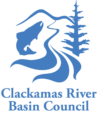
Running through land Managed primarily by the Mount Hood National Forest, the Collawash River flows through deep basalt canyons on its way to the Upper Clackamas. Alternating between extreme whitewater and deep green pools this part of the river lies in a remote area of the Bull of the Woods Wilderness.
At least a dozen lakes can be found among the peaks and ridges of the surrounding area and a 68 mile trail system winds its way through the old growth Douglas Fir, western hemlock and past deserted mine shafts. If you’re very lucky you might even spot a Northern Spotted Owl.
In the context of the entire Clackamas River, this portion of the basin is critical for the production of wild fish. Coho, spring Chinook, steelhead and resident cutthroat and rainbow trout spawn and rear in the watersheds of the Collawash and surrounding rivers. Because of the upper basin’s importance for wild fish, it is important to restore degraded areas and protect high quality habitats.
I live here, what can CRBC do for me?
- The Forest Service is pursuing a comprehensive habitat protection and restoration strategy for the Collawash River, Hot Springs Fork, and other tributaries that flow into the Upper Clackamas River. Current and past restoration actions were primarily focused on the Collawash River and Hot Springs Fork watersheds.
- CRBC is a member of the Clackamas Stewardship Partners, a group that works together to resolve conflicts over forest thinning projects that would have otherwise been litigated. CSP has also implemented on-the-ground restoration projects like road decommissioning and aquatic restoration. The group continues to build trust and understanding between the diversity of members at the table as well as between CSP members and the Forest Service. For their collaborative work, the Clackamas Stewardship Partners received the Two Chief’s Award.
